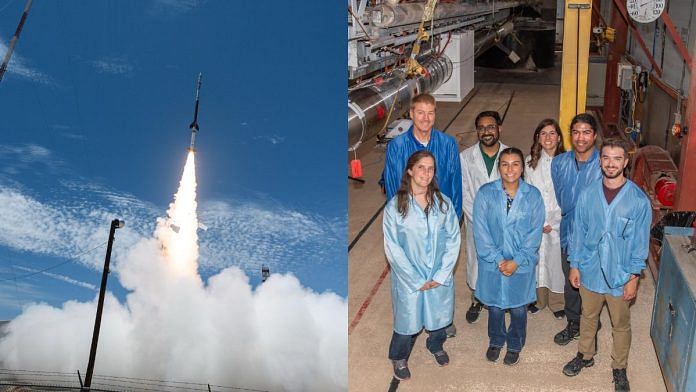New Delhi: NASA’s latest mission, the first-ever “sounding rocket” to space, has brought scientists closer to decoding the sun’s solar flares, eruptions, geomagnetic storms and other space weather phenomena that impact Earth’s satellites and telecommunications. The mystery rests in the layers of the Sun’s surface—specifically the chromosphere.
The chromosphere is located just below the outermost layer of the Sun known as the corona, and is one of the most “complex” regions of the Sun. While it is the corona where most solar eruptions are observed, scientists are convinced the chromosphere has a huge role to play in it.
The suborbital rocket was launched last week. The flight lasted only 15 minutes, but the Solar EruptioN Integral Field Spectrograph (SNIFS)—as the mission was called— marked the first time a field spectrograph was used to study solar eruptions from space. According to NASA, it could be the next “trailblazing spectator” of the Sun.
“The Sun’s visible layer photosphere is about 4000-6000 Kelvin hot, but the Corona can go up to 1 million Kelvin,” said Souvik Bose, solar physicist at Lockheed Martin and co-investigator of the SNIFS project. “So there’s clearly something happening in the middle layer, which is the chromosphere, that can help explain this. That’s what we’re trying to study.”
The SNIFS mission went up on a sounding rocket, which is a form of suborbital flight which tests space experiments. It has been under development since 2020, and was part of a joint project by NASA, Lockheed Martin Solar and Astrophysics Laboratory, and the University of Colorado. The main element of the mission was an integral field spectrograph.
A spectrograph is very simply a device that breaks down light rays into different wavelengths, and studies them individually. Since the Sun’s rays contain ultraviolet and far ultraviolet light, which isn’t visible to the naked eye, spectroscopy is a common method to study the energy and physics behind the Sun’s rays. The SNIFS, however, is an advanced version of the technology that both captures images and studies the Sun’s wavelengths.
“Previously, we’ve observed the Sun using spectroscopy, but they’ve been limited to narrow portions of the Sun,” explained Bose. “With SNIFS, we got multiple angles and a much broader scope of the Sun in 2D view because it is a field spectrograph.”
Bose described it as getting a picture at one traffic stop versus getting multiple pictures of traffic from multiple locations. With SNIFS, scientists can capture much higher speed and higher resolution of data with multiple dimensions of the Sun.
“Before, we would need to turn a spectrograph multiple times to cover more parts of the Sun. Now, with one 15-minute long flight, we have covered a broader area and get a fuller picture,” said Bose.
The sounding rocket was a way to test this new integral field spectrograph in space, and if successful, it could lead to future longer space missions with entire payloads built on the same technology.
Also Read: Big step for Samudrayaan as ISRO, NIOT complete key weld on deep-sea submersible after ‘700 trials’
Why the chromosphere?
According to a 2024 article by the National Solar Observatory in the US, the Sun’s chromosphere is “one of the most mysterious objects in astrophysics”. It is the place where the temperature, pressure and magnetic field of the Sun undergoes “dramatic changes”.
While the photosphere is what is visible to us from the Earth, it is the chromosphere where the magic is supposed to happen. For years, most missions to the Sun only used to carry imagers that would snap pictures of its rays and layers. However, to get an idea of the energy and heat radiated by the Sun, as well as the characteristics of sudden solar flares, spectroscopy is the way to go.
“We have some very powerful telescopes on Earth that use spectroscopy to study the Sun. But the thing is, the Earth’s atmosphere filters out quite a bit of UV rays before they reach us,” explained Bose.
Sending a spectrograph to space, beyond the Earth’s atmosphere, was, therefore, important to capture the ultraviolet rays that contain essential information about the sun such as what elements make up its rays. The chromosphere has been known to do something strange to elements too, according to Bose.
“The particles like hydrogen, magnesium, and iron are all neutral when they’re in the photosphere. But in the chromosphere, they’re ionised, so they gain charge,” he explained. “How does this happen? These are some questions that still persist about the chromosphere’s role in the Sun’s overall behaviour.”
The flight took place on 19 July in the White Sands Missile Range in New Mexico. The 15-minute-long suborbital flight reached a height of around 300 kms above the Earth’s surface before landing back safely. Now, the team behind the rocket will recover and analyse the data from the experiment, which could take up to a few months. However, Bose and his teammates know how the information from this could help open a new avenue of solar astrophysics.
“To make sure the Earth is safe from space weather, we really would like to be able to model things,” Vicki Herde, a doctoral graduate of University of Colorado Boulder, who worked on the project, said in a NASA press release.
(Edited by Mannat Chugh)
Also Read: Lift the veil, abandon Soviet-era approach. Indian science community wants ISRO to up its PR game




